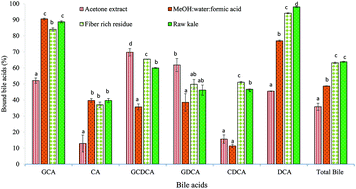In vitro digestion with bile acids enhances the bioaccessibility of kale polyphenols†
Abstract
Kale (Brassica oleracea) is a leafy green vegetable belonging to the Brassicaceae family, and kale leaves have large amounts of dietary fiber and polyphenolics. Dietary fiber can bind bile acids, thus potentially decreasing cholesterol levels; however, whether the polyphenols from kale contribute to in vitro bile acid binding capacity remains unclear. In the present study, kale was extracted with hexane, acetone, and MeOH : water and the dried extracts, as well as the fiber-rich residue, were tested for their bile acid binding capacity. The fiber-rich residue bound total bile acids in amounts equivalent to that bound by raw kale. The lyophilized acetone extract bound significantly more glycochenodeoxycholate and glycodeoxycholate and less of other bile acids. To test whether bile acid binding enhanced the bioaccessibility of polyphenolic compounds from kale, we used ultra-performance liquid chromatography coupled with electrospray ionization/quadrupole-time-of-flight mass spectrometry to identify chemical constituents and measure their bioaccessibility in an in vitro digestion reaction. This identified 36 phenolic compounds in kale, including 18 kaempferol derivatives, 13 quercetin derivatives, 4 sinapoyl derivatives, and one caffeoylquinic acid. The bioaccessibility of these phenolics was significantly higher (69.4%) in digestions with bile acids. Moreover, bile acids enhanced the bioaccessibility of quercetin by 25 times: only 2.7% of quercetin derivatives were bioaccessible in the digestion without bile acids, but with bile acids, their accessibility increased to 69.5%. Bile acids increased the bioaccessibility of kaempferol from 37.7% to 69.2%. The extractability and biostability of total phenolics in the digested residue increased 1.8 fold in the digestions with bile acids. These results demonstrated the potential use of kale to improve human health.

- This article is part of the themed collection: Around the Supermarket: Staple Foods


 Please wait while we load your content...
Please wait while we load your content...